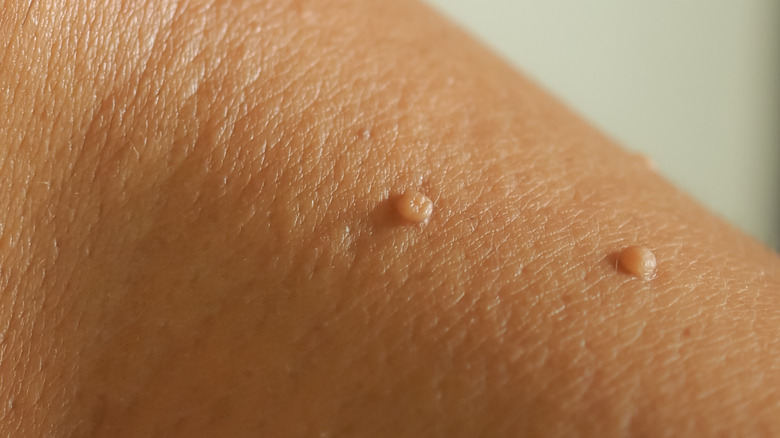Skin tags are small, soft, flesh-colored growths on the skin that can appear on various parts of the body. Often found in areas where skin rubs against skin or clothing, such as the neck, armpits, and groin, these benign tumors are common and generally harmless. Though they do not pose any medical threat, many people choose to remove them for aesthetic reasons or discomfort.
Note: Consult a dermatologist before removing skin tags to ensure the method is safe and appropriate for your skin type,” advises a skin expert. “Professional assessment is crucial, especially for larger or irregularly shaped skin tags, to avoid complications such as infection or scarring.
What are Skin Tags?
Before the methods of removal, it’s essential to understand what skin tags are. Skin tags, medically known as acrochordons, are small, soft, benign growths that appear on the skin’s surface. They often hang off the skin and can vary in size, ranging from a tiny pinpoint to a few millimeters. Skin tags are usually flesh-colored or slightly darker and are most commonly found on the neck, armpits, under the breasts and in the groin area. Though harmless, they can be bothersome and may affect your self-confidence.
Causes of Skin Tags
While the exact cause of skin tags is not entirely understood, several factors contribute to their development. The primary causes include:
- Friction: Skin-on-skin or skin-on-clothing friction in certain body areas can lead to the formation of skin tags.
- Obesity: Excess weight can increase the likelihood of developing skin tags due to increased friction and skin folds.
- Hormonal Changes: Fluctuations in hormones, especially during pregnancy, may trigger skin tag growth.
- Genetics: Family history plays a role and if skin tags run in your family, you may be more prone to developing them.
DIY Skin Tag Removal Methods
If you prefer trying natural or home remedies before seeking professional help, here are some effective DIY methods for skin tag removal:
1. Apple Cider Vinegar (ACV) Treatment
Apple cider vinegar contains acidic properties that can help dry out and remove skin tags. Soak a cotton ball in ACV and apply it directly to the skin tag, securing it with a bandage. Leave it overnight and repeat for several nights until the skin tag falls off.
2. Tea Tree Oil Solution
Tea tree oil has antiviral and antifungal properties, making it a potential remedy for skin tags. Mix a few drops of tea tree oil with a carrier oil like coconut oil and apply it to the skin tag. Repeat daily until the tag vanishes.
3. Duct Tape Method
Using duct tape to remove skin tags is an easy process. Cover the tag with a small piece of duct tape and leave it on for a few days. Afterward, remove the tape and check if the skin tag comes off with it.
Professional Skin Tag Removal Procedures
While DIY methods can work for some, professional skin tag removal procedures ensure safer and more effective results. Here are some common professional removal options:
1. Cryotherapy
Cryotherapy involves freezing the skin tag using liquid nitrogen, causing it to fall off. It is a quick and relatively painless procedure, but some mild discomfort and redness may occur afterward.
2. Electrocautery
Electrocautery uses an electrical current to burn off the skin tag. The procedure is performed under local anesthesia and usually takes only a few minutes.
3. Surgical Excision
For larger skin tags or those in sensitive areas, surgical excision may be recommended. The dermatologist will numb the area and carefully cut off the skin tag.
FAQs
Skin tags are generally harmless and not considered dangerous. However, if you notice any changes in color, size, or shape, consult a dermatologist.
Yes, you can use DIY methods like ACV or tea tree oil. However, it’s crucial to be cautious and ensure proper hygiene to avoid infection.
In some cases, skin tags may grow back after removal. However, regular skin care and monitoring can help manage their recurrence.
It is not recommended to cut off skin tags at home, as it may lead to bleeding, infection, or scarring. Leave removal to professionals or use safer DIY methods.
In most cases, skin tag removal is considered a cosmetic procedure and is not covered by insurance.
While some home remedies may not work for everyone, they are generally harmless to try. If a method doesn’t show results, consider professional removal options.
Conclusion
Skin tag removal doesn’t have to be a complicated or daunting process. Whether you opt for DIY methods or professional procedures, achieving clearer skin is within reach. Remember to understand what skin tags are, try natural remedies if you prefer and seek professional help if needed. By taking the necessary steps to remove skin tags, you can restore your confidence and enjoy healthier-looking skin.
